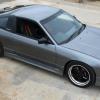Require more camber up front (ER34)
Announcements
-
Similar Content
-
Latest Posts
-
By TurboTapin · Posted
Do the following first and get back to us. - Clean and verify your IACV - Verify for vacuum leaks/post MAF leaks. (Pressure test is the best and cheapest way) - Do you have a BOV with stock ecu/MAF? If so, remove it. -
Hey all, The skyline I have is stalling when the engine is at normal operating temp. When starting it while it is cold, it'll run just fine. I have replaced the battery (bad cell), I have replaced the fuel pump, fuel filter and clean the MAF sensor. Any other suggestions?
-
Thanks for all the information on this. I tried ordering the parts from Amayama website and all 3 Solenoids are discontinued and not available. Does anyone have any other websites to suggest that I could find the parts? Separate issue-- I will start a new thread, but basically the vehicle is stalling when warmed up.
-
By TurboTapin · Posted
It's unfortunate what Tomei USA has done to Tomei's name in general. I'm very weary of ordering parts from them now. I only order direct from a Japanse source (e.g Nengun). At least their logos are different, so you end up knowing what you have. -
Update Issues 5 (plus #4) - 10 After making a claim about issue #4's missing part, DeAgostini Japan sent a whole new issue #4 and it arrived about 2 weeks after that. That was back in early March. It took another 4 weeks to receive issues 5 - 13 though. This update is for issues 5 - 10. Ove the 5 issues the front left suspension and most of the engine have been completed. The quality of the castings and fit of the parts is quite good, it seems better than DeAgostini's BNR34 Skyline GT-R from the Fast & Furious 2 movie, which (to me anyway) doesn't seem to have as tight tolerances or quite as accurate castings. Each issue has a lot of info about the 1989 - 1993 Skyline range and other Nissan models from that era, but the focus is on the BNR32 Skyline GT-R Nismo and the various racing it did in Japan, Europe (Spa 24hrs) and of course Australia. I've included some text translated with Google Lens in some photos and will add to them if there's anything worth including.
-






Recommended Posts
Create an account or sign in to comment
You need to be a member in order to leave a comment
Create an account
Sign up for a new account in our community. It's easy!
Register a new accountSign in
Already have an account? Sign in here.
Sign In Now